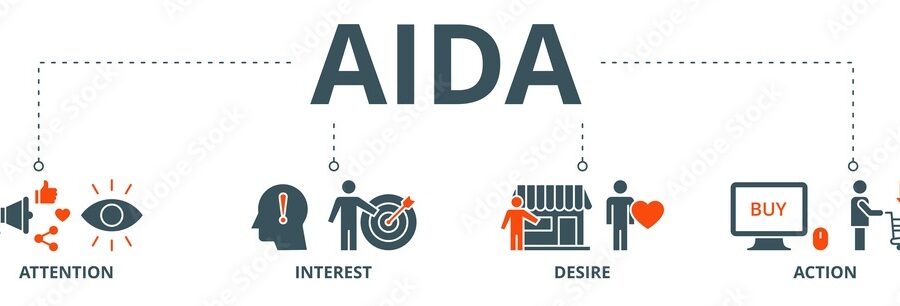In today’s digital age, businesses need to understand the importance of the AIDA model when creating marketing campaigns. AIDA framework, which stands for Attention, Interest, Desire, and Action, is a marketing model that helps businesses increase sales by taking potential customers through a four-stage process.
In this article, we’ll explore the AIDA framework in-depth and explain how it can help you outrank your competitors in Google search results.
What is the AIDA Framework?
The AIDA model is a framework that helps businesses create effective marketing campaigns that resonate with their target audience. It’s based on the four stages of the customer journey: Attention, Interest, Desire, and Action.
Attention:
This is the first stage of the AIDA model. The goal is to grab the customer’s attention by creating a compelling headline, tagline, or image. This can be achieved through social media, advertising, or content marketing.
Interest:
In the second stage, the goal is to generate interest in the product or service being offered. This is where businesses can start providing more information about the benefits of their product or service. By showcasing the value of their product or service, businesses can generate interest in potential customers.
Desire:
The third stage is where businesses create a desire for their product or service. This is done by highlighting the unique selling points of the product or service and showcasing how it can solve the customer’s problem. By creating desire, businesses can motivate potential customers to take action.
Action:
In the final stage, the goal is to get the customer to take action, whether that’s making a purchase, signing up for a service, or filling out a contact form. This can be achieved through call-to-action buttons, urgency tactics, or limited-time offers.
Why is the AIDA Model Important for SEO?
The AIDA model is important because it helps businesses create a clear and effective marketing strategy. By understanding the customer journey and the stages of the AIDA model, businesses can create targeted campaigns that resonate with their audience. This can lead to increased sales, improved brand awareness, and stronger customer relationships.
Benefits of The AIDA Framework
Some of the key benefits of the AIDA model include:
1. Provides a framework for creating effective marketing messages:
The AIDA model provides a structured approach for creating marketing messages that are designed to capture the attention of potential customers, generate interest in a product or service, create a desire for the product or service, and ultimately, motivate the customer to take action.
2. Helps businesses understand the customer journey:
By breaking down the customer journey into four stages, the AIDA model helps businesses better understand the needs and motivations of their target audience. This allows businesses to create more targeted and effective marketing campaigns that are tailored to the specific needs of their customers.
3. Improves the effectiveness of marketing campaigns:
By using the AIDA model to guide their marketing efforts, businesses can create more effective campaigns that are designed to move potential customers through the various stages of the buying process. This can help to increase conversion rates, boost sales, and improve overall marketing ROI.
4. Provides a clear call-to-action:
The AIDA model emphasizes the importance of providing a clear call-to-action (CTA) at the end of the marketing message. This helps to guide potential customers towards taking a specific action, such as making a purchase or signing up for a newsletter.
Overall, the AIDA model is a useful tool for businesses and marketers looking to create effective marketing campaigns that resonate with their target audience and drive results.
How to Use the AIDA Framework to Outrank Your Competitors
Now that we’ve covered the basics of the AIDA model, let’s explore how you can use it to outrank your competitors in Google search results.
1. Conduct Keyword Research:
Before you can start using the AIDA model in your marketing campaigns, you need to conduct keyword research. This will help you identify the keywords and phrases that potential customers are using to search for products or services in your industry.
2. Create Attention-Grabbing Headlines:
Once you have your list of keywords, it’s time to create attention-grabbing headlines that will capture the customer’s attention. Your headlines should be clear, concise, and focused on the benefits of your product or service.
3. Generate Interest with Compelling Content:
In the second stage of the AIDA model, you need to generate interest in your product or service. This can be achieved through compelling content that showcases the benefits of your offering. Your content should be informative, engaging, and focused on the customer’s pain points.
4. Create Desire with Unique Selling Points:
In the third stage, you need to create desire for your product or service. This can be achieved by highlighting the unique selling points of your offering and showcasing how it can solve the customer’s problem. By creating desire, you can motivate potential customers to take action.
5. Encourage Action with Strong CTAs:
The final step of the AIDA model is to encourage action with strong calls to action (CTAs). A call to action is a prompt or instruction that encourages the user to take a specific action, such as making a purchase or filling out a contact form. The CTA is an essential element of the AIDA model, as it helps to guide the user towards the desired action and ultimately leads to conversion.
Conclusion
The AIDA model is a proven framework for creating effective marketing messages that engage and persuade your audience. By focusing on each stage of the model, you can create a message that grabs attention, cultivates interest, creates desire, and encourages action.
Remember, the key to success with the AIDA model is to put yourself in your audience’s shoes and focus on providing value and benefits that speak to their needs and interests. With a little creativity and strategic thinking, you can create a marketing message that drives results and helps you achieve your business goals.
Q1. Is the AIDA model still relevant in today’s digital marketing landscape?
A. Absolutely. While the channels and tactics may have changed, the fundamental principles of the AIDA model still apply in today’s digital marketing landscape. By understanding your audience’s needs and interests, and focusing on creating a message that engages and persuades, you can create effective marketing campaigns across a wide range of channels and platforms.
Q2. Can the AIDA model be used for both B2B and B2C marketing?
A. Yes, the AIDA model can be used for both B2B and B2C marketing. Regardless of whether you’re selling to businesses or consumers, the key is to focus on the needs and interests of your target audience and create a message that speaks to those needs.
Q3. Can the AIDA model be used for all types of products and services?
A. Yes, the AIDA model can be used for all types of products and services. The AIDA model is a versatile framework that can be adapted to a wide range of marketing scenarios. Whether you are promoting a physical product, a digital service, or even a non-profit organization, the AIDA model can help you to create effective marketing campaigns.



